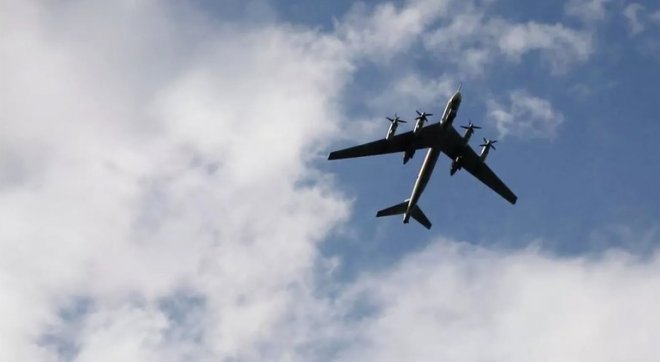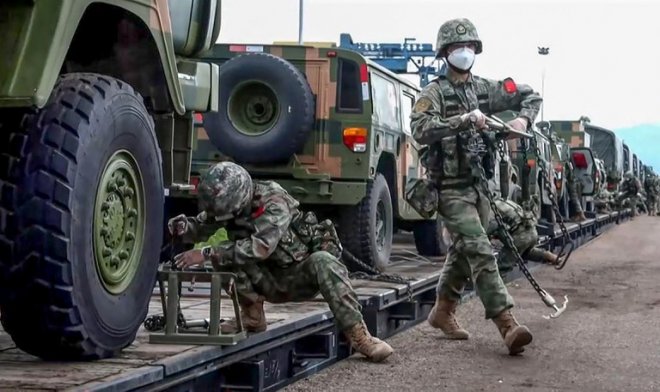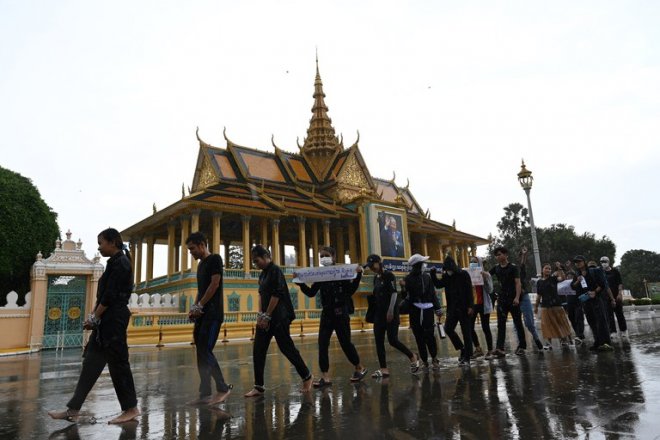China and Russia hold joint aircraft patrol over Asian waters
Chinese and Russian air forces held a joint patrol and an aircraft exchange in a show of growing defense ties amid strategic tensions with the United States.
The Chinese Ministry of Defense said in a brief statement that the two countries “conducted routine joint aerial strategic patrol in the air space over the waters of the Sea of Japan, the East China Sea and the west Pacific Ocean,” on Wednesday.
Russia’s Ministry of Defense meanwhile disclosed that several Russian Tu-95MS strategic bombers accompanied by Su-30SM and Su-35S fighter jets, and Chinese H-6K strategic bombers flew over the Sea of Japan and the East China Sea during an eight-hour mission.
Tu-95MS is a new variant of the Russian Air Force’s Tupolev Tu-95 strategic bomber and missile platform. It is capable of carrying modern Russian-made long-range and stealth cruise missiles.
![]() A file photograph of the Russian Air Force’s strategic missile bomber Tu-95MS. CREDIT: Russian Defense Ministry
A file photograph of the Russian Air Force’s strategic missile bomber Tu-95MS. CREDIT: Russian Defense Ministry
Russia said the two countries’ warplanes did not violate the airspace of any foreign states.
South Korea’s Joint Chiefs of Staff issued a statement Wednesday saying its military scrambled jets after eight planes entered the Korea Air Defense Identification Zone (Kadiz). It said they included two Chinese H-6 bombers and Russian Tu-95s and Su-35s which later reentered the zone but did not violate South Korean airspace.
The joint patrol was the second such operation this year and the fifth since the two air forces began their joint aerial activities in July 2019.
In the course of the joint patrol Russian aircraft also landed in China and Chinese bombers landed in Russia in the first aircraft exchange between the two air forces.
“These joint aerial patrols serve mainly as a symbolic act designed to send a message of Sino-Russian strategic unity to the U.S. and its Northeast Asian allies - Japan and South Korea,” said Artyom Lukin, Deputy Director for Research at the School of Regional and International Studies at Russia"s Far Eastern Federal University.
“Despite remaining largely a symbolic exercise, joint patrols do show an incremental increase in the level of interoperability between the two air forces,” Lukin told RFA.
Mutual trust
Chinese media said the patrol and the exchange “demonstrate further growth in high-level military cooperation and mutual trust between China and Russia” as they both face challenges from the West, especially the U.S.
The U.S. Defense Department released its 2022 National Defense Strategy in October, identifying China as “the overall pacing challenge” and Russia as “an acute threat” to the United States.
![]() A Chinese armed convoy arriving at the Vostok-2022 military exercises on Aug. 29, 2022. CREDIT: AFP/Russian Defense Ministry
A Chinese armed convoy arriving at the Vostok-2022 military exercises on Aug. 29, 2022. CREDIT: AFP/Russian Defense Ministry
In September China sent more than 2,000 troops, 300 vehicles of various types, 21 fixed-wing aircraft and helicopters, and three ships to take part in the Vostok-2022 wargame in Russia.
It was the first time the Chinese People"s Liberation Army (PLA) sent all three of its forces, the infantry, navy and air force, to participate in a single exercise in a foreign land.
Russia’s President Vladimir Putin and Chinese leader Xi Jinping held a summit in February, in which they praised the bilateral partnership as having "no limits" and "no forbidden areas of cooperation."
The Russia-initiated war in Ukraine has pushed the two countries even closer and Beijing has so far refused to condemn the Russian invasion.
In turn, Russia has backed China’s protests over the visit to Taiwan by U.S. House of Representatives Speaker Nancy Pelosi in August, calling it “provocative.”
China retaliated at the time by holding a large-scale military exercise around Taiwan.
Military alliance?
The U.S.’s main ally in East Asia, Japan, has also expressed concern about growing Russia-China ties as both Beijing and Moscow increase military activities near Japan.
On Aug. 24 Tokyo released its defense white paper, titled ‘Defense of Japan 2022’, in which it said that in recent years, “China and Russia have deepened their military cooperation.”
The two countries have conducted “long-distance joint flights from the East China Sea to the Sea of Japan and the Pacific Ocean every year since 2019,” the paper said.
On Tuesday, one day before the joint aerial patrol with Russia, Chinese Type 054A frigate Huanggang (577) and Type 956EM destroyer Taizhou (138) transited Tsushima Strait northbound from the East China Sea to the Sea of Japan, according to the Japanese Defense Ministry’s Joint Staff Office.
The coincidence in timing “hinted at joint aerial and naval operations by China and Russia,” said Artyom Lukin from the Russian Far Eastern Federal University.
In his opinion, questions remain over how far Moscow and Beijing are planning to take their military cooperation in terms of scale, integration, and geographic scope.
“Given the current trends, it can’t be ruled out that by the late 2020s or early 2030s the Pacific will see the emergence of a de facto, or perhaps even de jure, Sino-Russian military alliance,” the analyst said.
Currently China and Russia do not have a formal military alliance.
[圖擷取自網路,如有疑問請私訊]
The Chinese Ministry of Defense said in a brief statement that the two countries “conducted routine joint aerial strategic patrol in the air space over the waters of the Sea of Japan, the East China Sea and the west Pacific Ocean,” on Wednesday.
Russia’s Ministry of Defense meanwhile disclosed that several Russian Tu-95MS strategic bombers accompanied by Su-30SM and Su-35S fighter jets, and Chinese H-6K strategic bombers flew over the Sea of Japan and the East China Sea during an eight-hour mission.
Tu-95MS is a new variant of the Russian Air Force’s Tupolev Tu-95 strategic bomber and missile platform. It is capable of carrying modern Russian-made long-range and stealth cruise missiles.
 A file photograph of the Russian Air Force’s strategic missile bomber Tu-95MS. CREDIT: Russian Defense Ministry
A file photograph of the Russian Air Force’s strategic missile bomber Tu-95MS. CREDIT: Russian Defense MinistryRussia said the two countries’ warplanes did not violate the airspace of any foreign states.
South Korea’s Joint Chiefs of Staff issued a statement Wednesday saying its military scrambled jets after eight planes entered the Korea Air Defense Identification Zone (Kadiz). It said they included two Chinese H-6 bombers and Russian Tu-95s and Su-35s which later reentered the zone but did not violate South Korean airspace.
The joint patrol was the second such operation this year and the fifth since the two air forces began their joint aerial activities in July 2019.
In the course of the joint patrol Russian aircraft also landed in China and Chinese bombers landed in Russia in the first aircraft exchange between the two air forces.
“These joint aerial patrols serve mainly as a symbolic act designed to send a message of Sino-Russian strategic unity to the U.S. and its Northeast Asian allies - Japan and South Korea,” said Artyom Lukin, Deputy Director for Research at the School of Regional and International Studies at Russia"s Far Eastern Federal University.
“Despite remaining largely a symbolic exercise, joint patrols do show an incremental increase in the level of interoperability between the two air forces,” Lukin told RFA.
Mutual trust
Chinese media said the patrol and the exchange “demonstrate further growth in high-level military cooperation and mutual trust between China and Russia” as they both face challenges from the West, especially the U.S.
The U.S. Defense Department released its 2022 National Defense Strategy in October, identifying China as “the overall pacing challenge” and Russia as “an acute threat” to the United States.
 A Chinese armed convoy arriving at the Vostok-2022 military exercises on Aug. 29, 2022. CREDIT: AFP/Russian Defense Ministry
A Chinese armed convoy arriving at the Vostok-2022 military exercises on Aug. 29, 2022. CREDIT: AFP/Russian Defense MinistryIn September China sent more than 2,000 troops, 300 vehicles of various types, 21 fixed-wing aircraft and helicopters, and three ships to take part in the Vostok-2022 wargame in Russia.
It was the first time the Chinese People"s Liberation Army (PLA) sent all three of its forces, the infantry, navy and air force, to participate in a single exercise in a foreign land.
Russia’s President Vladimir Putin and Chinese leader Xi Jinping held a summit in February, in which they praised the bilateral partnership as having "no limits" and "no forbidden areas of cooperation."
The Russia-initiated war in Ukraine has pushed the two countries even closer and Beijing has so far refused to condemn the Russian invasion.
In turn, Russia has backed China’s protests over the visit to Taiwan by U.S. House of Representatives Speaker Nancy Pelosi in August, calling it “provocative.”
China retaliated at the time by holding a large-scale military exercise around Taiwan.
Military alliance?
The U.S.’s main ally in East Asia, Japan, has also expressed concern about growing Russia-China ties as both Beijing and Moscow increase military activities near Japan.
On Aug. 24 Tokyo released its defense white paper, titled ‘Defense of Japan 2022’, in which it said that in recent years, “China and Russia have deepened their military cooperation.”
The two countries have conducted “long-distance joint flights from the East China Sea to the Sea of Japan and the Pacific Ocean every year since 2019,” the paper said.
On Tuesday, one day before the joint aerial patrol with Russia, Chinese Type 054A frigate Huanggang (577) and Type 956EM destroyer Taizhou (138) transited Tsushima Strait northbound from the East China Sea to the Sea of Japan, according to the Japanese Defense Ministry’s Joint Staff Office.
The coincidence in timing “hinted at joint aerial and naval operations by China and Russia,” said Artyom Lukin from the Russian Far Eastern Federal University.
In his opinion, questions remain over how far Moscow and Beijing are planning to take their military cooperation in terms of scale, integration, and geographic scope.
“Given the current trends, it can’t be ruled out that by the late 2020s or early 2030s the Pacific will see the emergence of a de facto, or perhaps even de jure, Sino-Russian military alliance,” the analyst said.
Currently China and Russia do not have a formal military alliance.
[圖擷取自網路,如有疑問請私訊]
|
本篇 |
不想錯過? 請追蹤FB專頁! |
| 喜歡這篇嗎?快分享吧! |
相關文章
AsianNewsCast





















